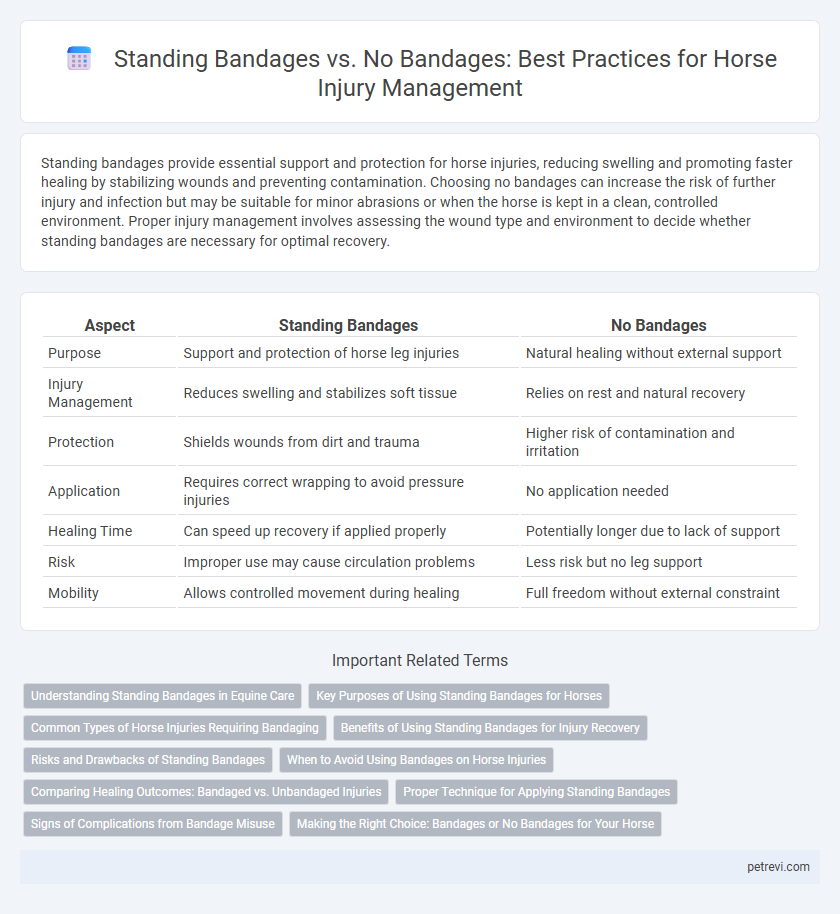Standing bandages provide essential support and protection for horse injuries, reducing swelling and promoting faster healing by stabilizing wounds and preventing contamination. Choosing no bandages can increase the risk of further injury and infection but may be suitable for minor abrasions or when the horse is kept in a clean, controlled environment. Proper injury management involves assessing the wound type and environment to decide whether standing bandages are necessary for optimal recovery.
Table of Comparison
| Aspect | Standing Bandages | No Bandages |
|---|---|---|
| Purpose | Support and protection of horse leg injuries | Natural healing without external support |
| Injury Management | Reduces swelling and stabilizes soft tissue | Relies on rest and natural recovery |
| Protection | Shields wounds from dirt and trauma | Higher risk of contamination and irritation |
| Application | Requires correct wrapping to avoid pressure injuries | No application needed |
| Healing Time | Can speed up recovery if applied properly | Potentially longer due to lack of support |
| Risk | Improper use may cause circulation problems | Less risk but no leg support |
| Mobility | Allows controlled movement during healing | Full freedom without external constraint |
Understanding Standing Bandages in Equine Care
Standing bandages provide crucial support to a horse's lower limbs, helping reduce swelling and protect wounds during injury recovery. These bandages stabilize tendons and ligaments, promoting faster healing while preventing contamination and further damage. Proper application of standing bandages is essential to avoid circulation issues and ensure effective equine care.
Key Purposes of Using Standing Bandages for Horses
Standing bandages provide essential support and protection to a horse's legs by minimizing swelling, securing wounds, and preventing contamination during injury management. They promote proper circulation and reduce the risk of further trauma or strain by stabilizing injured tendons and ligaments. Proper application of standing bandages facilitates faster healing and helps maintain leg hygiene, crucial in equine recovery protocols.
Common Types of Horse Injuries Requiring Bandaging
Common types of horse injuries requiring bandaging include cuts, abrasions, and tendon strains, which benefit from standing bandages to provide support and protect wounds during healing. Standing bandages help reduce swelling and prevent dirt contamination, especially in leg injuries such as bowed tendons or superficial digital flexor tendonitis. Without bandages, these injuries risk worsening due to lack of stabilization and exposure to environmental irritants.
Benefits of Using Standing Bandages for Injury Recovery
Standing bandages provide essential support and compression to reduce swelling and promote faster healing in horse injury management. They protect wounds from dirt and external contaminants, minimizing infection risks. Improved circulation and stabilized tissues during recovery enhance overall treatment outcomes for equine injuries.
Risks and Drawbacks of Standing Bandages
Standing bandages in horse injury management carry risks such as restricting circulation, leading to swelling or tissue damage if applied improperly. Prolonged use can cause pressure sores and exacerbate underlying injuries by limiting natural movement essential for healing. Neglecting regular monitoring increases the likelihood of complications like infection or delayed recovery compared to no bandages.
When to Avoid Using Bandages on Horse Injuries
Avoid using standing bandages on horse injuries when the wound is heavily contaminated, as bandages can trap debris and moisture, increasing infection risk. Do not apply bandages to open wounds with active bleeding or severe swelling, since improper pressure might exacerbate tissue damage. Horses with skin sensitivities or allergic reactions should also avoid bandages to prevent irritation and delayed healing.
Comparing Healing Outcomes: Bandaged vs. Unbandaged Injuries
Standing bandages provide essential support and protection to equine wounds, significantly reducing the risk of contamination and swelling compared to unbandaged injuries. Studies show that horses with bandaged injuries exhibit faster healing rates and lower incidences of complications such as edema and infection. In contrast, unbandaged wounds are more prone to environmental exposure, which can delay recovery and increase the likelihood of secondary damage.
Proper Technique for Applying Standing Bandages
Proper technique for applying standing bandages on horses is crucial to prevent injury and promote effective healing. Use clean, padded materials and wrap firmly but not too tight, starting from the middle of the limb and moving in a spiral motion upward to avoid pressure points and restrict circulation. Secure the bandage with appropriate tape or clips, ensuring it remains stable during movement while allowing for swelling and ventilation.
Signs of Complications from Bandage Misuse
Improper use of standing bandages on horses can lead to signs of complications such as swelling above or below the bandage, increased lameness, and impaired circulation indicated by cold extremities or digital pulses. Monitoring for tightness-related pressure sores, skin irritation, and increased heat in the bandaged area is crucial to prevent worsening of injuries. Early detection of these symptoms allows timely adjustment or removal of the bandage, promoting effective healing and avoiding further tissue damage.
Making the Right Choice: Bandages or No Bandages for Your Horse
Standing bandages provide crucial support and protection for equine injuries by reducing swelling and preventing contamination, making them highly effective for managing wounds and strains. However, improper application or prolonged use can lead to circulation issues or skin irritation, highlighting the importance of correct technique and regular monitoring. Choosing between bandages or no bandages depends on the injury type, location, and veterinary advice, ensuring optimal healing without compromising the horse's comfort or mobility.
Standing Bandages vs No Bandages for Horse Injury Management Infographic

 petrevi.com
petrevi.com